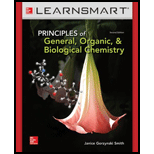
Concept explainers
(a)
Interpretation:
The acid, base, conjugate acid and conjugate base of the reaction has to be labeled.
The given equation is,
Concept Introduction:
Bronsted-Lowry Acids: A Bronsted-Lowry acid is proton donor and contains a hydrogen atom. It may be a neutral molecule or may contain a net positive or negative charge.
Bronsted-Lowry Bases: A Bronsted-Lowry base is a proton acceptor. A base should contain a lone pair of electrons, which donates to form a new bond. It can be neutral or can contain a negative charge.
Conjugate acid: A conjugate acid is the product formed by a gain of a proton by a base. The conjugate acid of the base B will be
Conjugate base: A conjugate base is the product formed by a loss of proton from an acid. The conjugate base of the acid A will be
(a)
Answer to Problem 8.55AP
The acid in the reaction is
The conjugate base of the acid is
The base in the reaction is
The conjugate acid of the base is
Explanation of Solution
Acid loses a proton and forms conjugate base.
Base accepts a proton and forms conjugate acid.
The given reaction is,
Hydroiodic acid loses its proton to form iodide. Ammonia gains a proton to form ammonium ion.
(b)
Interpretation:
The acid, base, conjugate acid and conjugate base of the reaction has to be labeled.
The given equation is,
Concept Introduction:
Refer to part (a).
(b)
Answer to Problem 8.55AP
The acid in the reaction is
The conjugate base of the acid is
The base in the reaction is
The conjugate acid of the base is
Explanation of Solution
The given reaction is,
Formic acid loses a proton to form formate ion. Water gains a proton and forms hydronium ion.
(c)
Interpretation:
The acid, base, conjugate acid and conjugate base of the reaction has to be labeled.
The given equation is,
Concept Introduction:
Refer to part (a).
(c)
Answer to Problem 8.55AP
The acid in the reaction is
The conjugate base of the acid is
The base in the reaction is
The conjugate acid of the base is
Explanation of Solution
The given reaction is,
Hydrogen sulphate
Want to see more full solutions like this?
Chapter 8 Solutions
Connect Access Card for Principles of General, Organic & Biochemistry
- Mark each of the following statements True or False: a. The conjugate base of a strong acid is always a weak base. b. The conjugate acid of a strong base is always a weak acid. c. The stronger the acid, the weaker its conjugate base, and vice versa.arrow_forwardSolution A has a pH of 2.0. Solution B has a pH of 5.0 Which solution is more acidic? Based on the H+ ion concentrations in the two solutions, how many times more acidic?arrow_forwardWrite equations that show NH3 as both a conjugate acid and a conjugate base.arrow_forward
- Use Table 14.3 to help order the following acids from strongest to weakest HNO3,H2O,NH4+,C5H5NH+arrow_forwardThe ideal pH of a swimming pool is 7.2. You measure the pH of your pool to be 6.5. What should you add, acid or base, to restore your pool to the ideal pH? acid base neitherarrow_forward. Choose pairs in which the species listed first is the conjugate base of the species listed second. a. S2-, HS- b. H+, OH- c. HBr, Br- d. NO2, HNOarrow_forward
- Several acids and their respective equilibrium constants are: Which is the strongest acid? Which is the weakest acid? Which acid has the weakest conjugate base? Which acid has the strongest conjugate base?arrow_forwardConsider the following four solutions: (1) apple juice, pH 3.8, (2) pickle juice, pH 3.5, (3) carbonated beverage, pH 3.0, and (4) drinking water, pH 7.2. a. Which solution has the highest [H3O+]? b. Which solution has the highest [OH]? c. List the solutions in order of increasing acidity. d. List the solutions in order of decreasing basicity.arrow_forwardConsider the following four biological solutions: (1) bile, pH 8.0, (2) blood, pH 7.4, (3) urine, pH 6.0, and (4) gastric juice, pH 1.6. a. Which solution has the lowest [H3O+]? b. Which solution has the lowest [OH]? c. List the solutions in order of decreasing acidity. d. List the solutions in order of increasing basicity.arrow_forward
 World of Chemistry, 3rd editionChemistryISBN:9781133109655Author:Steven S. Zumdahl, Susan L. Zumdahl, Donald J. DeCostePublisher:Brooks / Cole / Cengage Learning
World of Chemistry, 3rd editionChemistryISBN:9781133109655Author:Steven S. Zumdahl, Susan L. Zumdahl, Donald J. DeCostePublisher:Brooks / Cole / Cengage Learning Chemistry: The Molecular ScienceChemistryISBN:9781285199047Author:John W. Moore, Conrad L. StanitskiPublisher:Cengage Learning
Chemistry: The Molecular ScienceChemistryISBN:9781285199047Author:John W. Moore, Conrad L. StanitskiPublisher:Cengage Learning Organic Chemistry: A Guided InquiryChemistryISBN:9780618974122Author:Andrei StraumanisPublisher:Cengage Learning
Organic Chemistry: A Guided InquiryChemistryISBN:9780618974122Author:Andrei StraumanisPublisher:Cengage Learning Introductory Chemistry: A FoundationChemistryISBN:9781337399425Author:Steven S. Zumdahl, Donald J. DeCostePublisher:Cengage Learning
Introductory Chemistry: A FoundationChemistryISBN:9781337399425Author:Steven S. Zumdahl, Donald J. DeCostePublisher:Cengage Learning Chemistry by OpenStax (2015-05-04)ChemistryISBN:9781938168390Author:Klaus Theopold, Richard H Langley, Paul Flowers, William R. Robinson, Mark BlaserPublisher:OpenStax
Chemistry by OpenStax (2015-05-04)ChemistryISBN:9781938168390Author:Klaus Theopold, Richard H Langley, Paul Flowers, William R. Robinson, Mark BlaserPublisher:OpenStax





